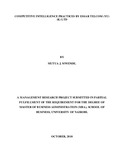| dc.description.abstract | As global economic competition increase globally, both public and private sector are faced with an increasing competitive environment where sustained competitive advantage is increasingly becoming difficult to maintain. Consequently, many organizations, whether public or private, are initiating their own competitive intelligence (CI) services to advise their decision makers. The purpose of this study was to determine the competitive intelligence practices used by Essar Telecom (YU) (K) Ltd.
The study adopted a case study design as it enables the researcher to have an in-depth understanding of the study. The study used primary data and the key instrument for data collection was interview guide and the sampling design was convenience sampling. An interview guide containing structured and unstructured questions were administered through face to face interviews with the senior employees who included the managers in sales, marketing, business development, and corporate relations department. Data analysis was done through several qualitative techniques such conceptual analysis, content analysis and pattern! trends analysis as dictated by study themes.
The study major findings were, the study observed that Kenyan mobile market has been highly competitive (60%) more than ever before. The study further noted that the strategic actions adopted for market penetration include, new differentiated and innovative products for example data (93), mobile phone money transfers, cost reduction (87%), infrastructure development (66%) through availing cheap quality handsets and market segmentation so as to target the youths (11 %). Study showed the existence of various level of competitive intelligence practices within the study organisation which included, gaining an understanding
ofa competitor's future goals, analysis of competitor's current strategy, analysis of assumptions held about itself and the industry and capabilities, analysis of competitors price policies and the plans they have for changing the way in which they differentiate their products and finally defending company secrets from leaks to the competitors. Notably, the study also observed that competitive intelligence activities within the study organisation were spontaneous based on the competitor's activities.
Results illustrated that there were numerous sources of CI information which include, research and development, CI consultants carried the analysis of gathered competitive intelligence information from CCK and replication of parent company telecommunication solutions to local solutions. Majority (53%) of the interviewees in the discussion noted that competitive intelligent in their organisation was moderately effective in market penetration of their organisation. Although the study organisation had to some extent embraced CI as a tool for market penetration, the organisation to lacked budgetary allocation for CI activities in the organisation, trained personnel on CI planning, implementation and coordination.
The study recommends the need to fully internalize the competitive intelligence activities in the organisation structure and more specifically the organisation should be able to set objectives for the CI department and establish job descriptions for every responsibility center. Furthermore, CI activities objectives and aspirations should be incorporated into the overall strategic plan for the whole organisation, this would position the CI function as one of the top department. | en_US |

